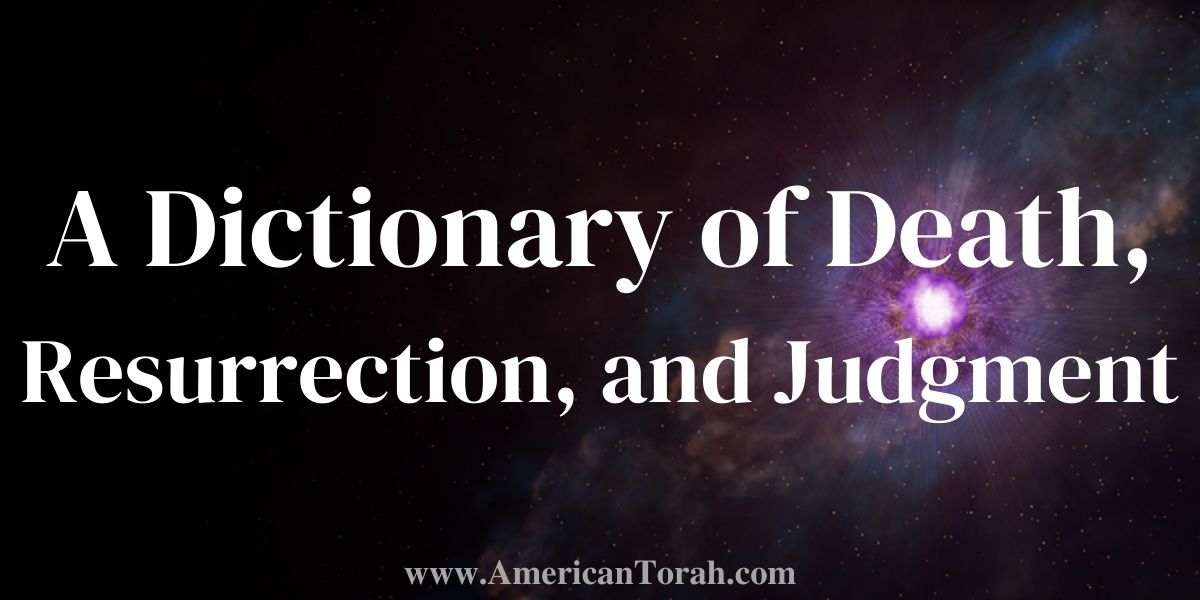I created this short glossary as an aid in studying the topics of death and the afterlife in Scripture. Although it is based on extensive reading in the Bible, I am not a scholar of biblical languages or ancient cultures, so it is almost certainly erroneous in some respects. I will make changes as I learn more.
Please feel free to offer your own thoughts in the comments, with the understanding that I am looking for truth, not mere mythology. I’m sure that the beliefs of the Norse and the Navajo concerning what happens when we die are fascinating, but they are irrelevant to this glossary unless they can help us to understand what the Hebrew prophets knew about these things.
- Book of Life – A listing of the names of all those who will be granted eternal life at the Final Judgment. It doesn’t contain merely their first and last names, the written and spoken labels by which we all address one another, but the sum of each person’s character. This is one writing in a collection kept in Heaven, the other members of which apparently describe the deeds of each person, righteous and wicked alike, in more detail. See Daniel 7:10, Revelation 13:8, and 20:12.
- The Final Resurrection – The resurrection of all who remain in Sheol at the time of the Final Judgment. See Daniel 12:2 and Revelation 20:12-13.
- The First Resurrection – The resurrection at the time of Yeshua’s Second Coming of faithful believers who were killed during the Great Tribulation. See 1 Thessalonians 4:16 and Revelation 20:4.
- Gehenna – Literally, the Valley of Hinnom, apparently once known as the Valley of the Sons of Hinnom. See 2 Chronicles 28:3.
- Literally this is the Valley of Hinnom, where the Canaanites and idolatrous Israelites made human sacrifices long before the Babylonian dispersion, and which was later used as a public dump for garbage and corpses, both animal and human. It was a place of decay, stench, and fires. Even now, landfills are subject to frequent spontaneous fires that can burn beneath the surface for months or even years.
- Figuratively, Gehenna refers to a place of fire and destruction where the wicked are sent after judgment. See Lake of Fire.
- The Grave – See Sheol.
- The Great Tribulation – A period in which the earth is subject to waves of devastating plagues, wars, natural disasters, and the reign of two figures known as the Beast and the False Prophet. See Daniel 7-9, Matthew 24:21-29, and Revelation 11-13.
- Hades – See Sheol.
- Heaven – The seat of God’s court and location of his putative residence. The skies are also called “heaven” and the ancients believed that God’s Heaven was located somewhere in the sky. However, God’s Heaven is not a physical place that a person could see through a telescope or travel to in any vehicle that could be made by human technology. It might exist in a higher dimension (whatever that means) or in some other universe or it might simply be a realm of pure spirit, undetectable in any direct fashion by beings with physical bodies.
- Hell – See Lake of Fire.
- Lake of Fire – A place of darkness, fire, and destruction where death, Sheol, Satan, Satan’s angelic followers, and all whose name is not found in the Book of Life will be thrown at the time of the Final Judgment. What most people think of when they hear the word “Hell”. See Matthew 13:40-43, Revelation 19:20, and Revelation 20:7-15.
- The New Earth – A physical planet earth that will be newly created after the present earth is completely destroyed. See Isaiah 65:17 and Revelation 21:1.
- The New Heaven – A physical universe that will be newly created after the present universe is completely destroyed. See Isaiah 65:17 and Revelation 21:1.
- The New Jerusalem – A massive, cuboid city made of precious metals and stones that will descend from the sky to take the place of the old city of Jerusalem on the New Earth. See Revelation 21.
- Second Coming – The return of Yeshua to earth following the Great Tribulation to reign personally from Jerusalem for one thousand years. See Matthew 24:30, 1 Thessalonians 4:15-17, and Revelation 19.
- Sheol – The Hebrew word for the place where the spirits of the dead go to await resurrection. Equivalent to the Greek word Hades. Sometimes translated as “the grave”, “Tartarus”, or “Hell”, but most people today use the word “Hell” to refer to the Lake of Fire, which is not the same as Sheol. See Genesis 37:35, 1 Samuel 2:6, and Luke 16:19-31.
- Soul – The entirety of a living being, including body, spirit, and mind. We are a soul and we are partly made up of body and spirit. Animals are souls, because they are living beings. The Hebrew word used in Scripture for soul is nephesh, translated variously as soul, creature, being, person, etc.. See Genesis 2:7 and 27:4, for example. Most English speakers, including Bible translators, use the words soul and spirit almost interchangeably, but that makes it difficult to talk about two distinct Biblical concepts, for which we would otherwise not have distinct terms. For the purposes of this discussion, I intend to use the word soul to refer to the whole being and the word spirit to refer only to that aspect of a person which continues to exist as a distinct entity after the physical body has died.
- Spirit – Usually translated from the Hebrew word ruach but sometimes also from neshamah. Although the second meaning below is probably the most common usage in Scripture, for the purposes of this discussion, I will be using the first definition.
- The incorporeal component of a living soul that continues to exist as a distinct entity after the physical body has died. See Job 32:8 and Psalm 31:5.
- The morale and/or motivating will of a person. See Exodus 35:21 and Proverbs 17:22.
- A state of mind or strong tendency. See Exodus 28:3 and Numbers 5:14.
- A non-human spiritual being that does not normally have a physical body. See 1 Samuel 16:14 and 1 Kings 22:21.
- Tartarus – See Sheol.
Watch the Afterlife category for upcoming related articles!
Everything that Yeshua (aka Jesus) & the Apostles taught
Come with me as I draw out the connections that are so often missed |


